Don't text while driving! That's the message the Gwent (Wales, UK) Police Department wants to send to us. And I think in this format the message is VERY clear: Cassie Cowan kills 4 people in a car accident because she gets distracted by using her cellphone while driving.
Be warned: What you are about to see is EXTREMELY GRAPHIC!!!!!
And here's NBC's The Today Show on that topic:
Bear with me while I'm trying to manoeuvring through the life in a country that most people from outside know as the home of chocolate, cheese with big holes, accurate watches and a quirky language. And in case you haven't noticed: Cuckoo-Clocks are German!
Donnerstag, 27. August 2009
Sonntag, 16. August 2009
Colléction Schlumpf, Mulhouse
Hans Schlumpf ran a yarn factory in Mulhouse. His factory held the monopoly for rough yarn all over France, which gave him absolute control of the market for this yarn. That made him a wealthy man. Unfortunately he and his brother Fritz had a very expensive hobby: They collected cars. Old cars. Antique cars. And here comes the sad story: Not only did they spend every single penny of their own pile into their car collection, they also used money from Hans’ company to buy more and more cars. In 1977 the company went bankrupt, leaving over 2000 people without a job. At a raid during a strike in 1977 the mob discovered the 400+ cars. Selling all these vehicles – the oldest was built in 1886 – would have brought all the money to pay the company’s debts. But the French government insisted and turned the old factory halls into a museum, the ‘Cité d’Automobile’, City of Cars.
The vast majority of the cars in the collection are French built cars, such as: 19 Panhard & Levassor, 19 Renault, 29 Peugeot etc, etc. But the highlight of the museum are 123 Bugattis. Amongst them are 2 Type 41 Royale from the original Schlumpf Collection, and a replica of a third one. Only six of these wonderful automobiles where ever built.
Here are some of the highlights of the museum:
Bugatti Type 35
If anybody hadn't heard about Bugatti cars in 1924, this changed with the Type 35. Approx. 200 of all variants were built, more than 2000 races were won until 1930. Bentley, Alfa-Romeo, Mercedes, you name it, Bugatti beat it with this car. This was the car that finally created the legend of the brand.
Bugatti Type 41 Royale
Built for Royals, but none of them were interested... Only 6 cars were built in total, two of them are exhibited in Mulhouse, also the replica of the Royale Roadster.
Bugatti Type 46
The Type 46 from 1929 was a direct hit against the Mercedes-Benz SS and the Hispano-Suiza H6B. Its 5.3 liter engine was smaller than the engines of the opponents, but Bugatti had enough expertese to make up for that with power and stamina. And of course the body looked like the american cars of that time. The car was also known as 'Petit Royale'.
Bugatti Type 50 T
Had the Type 46 established the brand Bugatti all over the world - the Type 50 should now prove that this wasn't just by accident. 'Le Patron' Ettore brought his 20 year old son Jean into the company, and he was responsible for rhis construction and for the breathtaking design of the T-Todel. The 'normal' Type 50 raced the 24 heurs du Mans 4 times, but none of the cars ended the race, mainly because of damaged tires. This was also a problem for the T-Model, as the engine produced 275 hp which was too much for the tires.
Bugatti Type 57
Ettore Bugatti's son Jean built this car, and also designed some of the most spectacular carbodies of all times for it. The bodies Ventoux, Galibier, Stelvio and especially the breathtaking Atlantic Coupé, of which only a handful were built, remain unforgetable.
Type 57 C Galibier:
Atlantic Coupé - extremely rare!
The replica of the famous Type 57S Atalante Coupé:
Bugatti Type 101
After Ettore's death in 1947 the company only built one more model. But without the genius on the helm, the car remained unsucessful. Actually the company missed to do new developments, and so this car was basically a Type 57 with a new body - so the car was basically 25 years old when actually came out...
This Type 101 obviously does not have its original body anymore. It's been redesigned by an italian designer.
Bugatti Type 251
The attempt to build a car for the new 2.5-liter formula ended in a disaster. Although Gioacchimo Colombo - the father of Ferraris pre-1954 12-cyclinder engines - had designed the engine the car lasted only half a race.
Both Ettore Bugatti and his son Jean had died already years ago, and the small company from Molsheim had financial problems and was taken over by Hispano-Suiza in 1963. In 1966 Simca bought Hispano-Suiza, and the brand Bugatti disappeared.
Bugatti EB 16/4 Veyron
Well, yes, it's a Bugatti... In 1987 Romano Artoli founded the Bugatti International Holding in Luxemburg. He knows people who have money. On September 14 and 15 in 1991 the EB110 is being presented on the Place de la Défence in Paris and in the original factory halls in Molsheim. Many former Ferrari and Lamborghini constructors have worked on the car, but the audience misses the connection with the original Bugattis. 139 cars have been built, plus the prototype of the limousine EB112, when in 1995 the company is going bankrupped. Artoli and his crew have created a financial mess.
When it comes to exotic cars, big brands have the advantage: Ferrari, Alfa Romeo and Maseratti belong to Fiat, Lamborghini once belonged to the Mimram family, before it was sold to Chrysler, then to Mega Tech in Indonesia, and now it belongs to Volkswagen. And Volkswagen also bought the rights of the name Bugatti in 1998. After various design-studies the EB 16/4 Veyron is being presented in 2000, production begins in 2003 in Molsheim - but not in the old factory halls, since they still belong to Hispano-Suiza-Mercier. 16 cylinders, 4 turbochargers, 1001 hp, 406 km/h - that's truly Bugatti-like. Although, not much is left from the myth in this car...
Ferrari 500 TRC
The Testa Rossa saga began in 1957 and ended in 1962. The concept was to create a competitive open-bodied race-car for gentlemen-drivers, who didn't have the opportunity to race for a factory team. So Testa Rossas were hardly ever operated by the Scuderia Ferrari. The model 500 TRC was actually the last ever Ferrari to have a 4-cylinder engine. The Testa Rossa saga found a follow-up in the timeless ugly 512BB Testarossa from 1984.
Although looking roughly the same, this car is not a Testa Rossa. The bodyshops Scaglietti and Fantuzzi in Modena used the same design from Pinin Farina for several open-bodied racing cars, so it's very difficult to tell the difference. This one could be a 412MM or a 860 Monza.
Ferrari 250 GT Lusso
The Ferrari 250 in all its variants marked the beginning of the Golden Age for the italian company with the jumping horse. Most of the cars were designed by Pininfarina, who's name by then still was Pinin Farina. Ferrari built a so-called rolling chassis with the engine, and sent this to Scagliatti, who built the body of the car and the interior. This particular car already showed typical 1970s elements back in the late fifties.
Ferrari 250 Le Mans
Although not a real 250 model (the number means the ccm per cylindre) but rather a 330, Ferrari tried to cheat the FIA on this one. The car was presented as a race-variant of the 250 SWB from 1959, but really had nothing in common with this one. The FIA found out what had happened, and the car was banned from the 3-litre races. It had to compete with much more powerful opponents, which eventually lead to the legendary P-Series, ending with the 330 P3 and P4.
Alfa Romeo 8C 2,9 A
With the 8C - stands for 8 cylinders - Alfa Romeo presented a new generation of sports cars in 1931. The car first had 2300 ccm, in 1936 the engine was enlarged to 2900 ccm. About 30 cars were made of that type, with some of the most elegant bodies ever seen and very typical for that time.
Arzens La Baleine
Paul Arzens was a French designer who designed many locomotives for the SNCF. Also he constructed two cars: La Baleine and L'Oef. La Baleine was based on the chassis of a Buick, and wich it's streamline shape it was 40 km/h faster than the american original.
This car is not part of the original Colléction Schlumpf, as it was in use until Azens' death in 1990.
Trabant 601
How many people do you need to build a Trabant? 5: Four fold the cardboard, one handles the glue...
This car represents more than anything else the lifestyle in the DDR / GDR. It's twin-stroke engine with 600 ccm produced 27 hp, enough for 107 km/h topspeed.
This car is not part of the original Colléction Schlumpf.
The Group B Monsters
Ford RS200
Peugeot 205 Turbo 16
In 1984 the FIA introduced a new formula into Rally Sports: Group B. I won't bother you with reglementation details, just so much: Allowed was basically everything, as long as you produced 200+ cars of that model. This lead to this legendary Peugeot 205 Turbo 16, with 500 hp, AWD, and a weight of only 900 kg. The engine was mounted in the middle of the car, behind the driver's and copilot's seat. Technically these cars had absolutely nothing in common with the 'original' 205 that populated european streets in the 80s and 90s, the RS200 never even had a 'brother' for normal street use. Once unleashed, the engine turned the care into a rocket on wheels, hardly controllable by its driver. Many fatal accidents within a very short period forced the FIA to bring this adventure to an end in 1986. Never again have so highly overpowered vehicles entered a rally-track, but the thundering sound of the engines, the puffing of the whastegate-valves and the turbine-like whining of the gearbox still brings goosebumps to fans.
These cars are not part of the original Colléction Schlumpf.
Here's for some Action:
Mercedes-Benz 300 SL Roadster
After the success of the SSL and the W154 forumla cars back in the 30s Mercedes-Benz tried to catch up to the Ferraris and Porsches after WWII. The result was the 300 SL, which was built as coupes and roadsters, both for normal use and for racing.
Porsche 962
In the early 80s Porsche dominated the so-called Group C with the model 956 and its successor 962. The engine was an evolution-version of the original 911 engine.
This car is not part of the original Colléction Schlumpf.
Audi R8
The successor of the Group C in track racing is todays Le Mans Series. The peak of the series is the 24 heurs du Mans, the 24 hour race. The prototypes are the kings of the road, and Audi won the race 6 times with the R8, plus many more races in total.
This car is not part of the original Colléction Schlumpf.
PS: I appologize for the messup with the name Franco Sbarro in the first version of this blog, and I want to point it out very clearly here: Franco Sbarro had NOTHING to do with the Bugatti-disaster in the early nineties. He was not involved in the EB110 project. His connection with the name Bugatti is a replica of the Type 41 Royale that has been built until 1983.
The vast majority of the cars in the collection are French built cars, such as: 19 Panhard & Levassor, 19 Renault, 29 Peugeot etc, etc. But the highlight of the museum are 123 Bugattis. Amongst them are 2 Type 41 Royale from the original Schlumpf Collection, and a replica of a third one. Only six of these wonderful automobiles where ever built.
Here are some of the highlights of the museum:
Bugatti Type 35
If anybody hadn't heard about Bugatti cars in 1924, this changed with the Type 35. Approx. 200 of all variants were built, more than 2000 races were won until 1930. Bentley, Alfa-Romeo, Mercedes, you name it, Bugatti beat it with this car. This was the car that finally created the legend of the brand.
 |
| Von Colléction Schlumpf |
 |
| Von Colléction Schlumpf |
Bugatti Type 41 Royale
Built for Royals, but none of them were interested... Only 6 cars were built in total, two of them are exhibited in Mulhouse, also the replica of the Royale Roadster.
 |
| Von Colléction Schlumpf |
 |
| Von Colléction Schlumpf |
Bugatti Type 46
The Type 46 from 1929 was a direct hit against the Mercedes-Benz SS and the Hispano-Suiza H6B. Its 5.3 liter engine was smaller than the engines of the opponents, but Bugatti had enough expertese to make up for that with power and stamina. And of course the body looked like the american cars of that time. The car was also known as 'Petit Royale'.
 |
| Von Colléction Schlumpf |
Bugatti Type 50 T
Had the Type 46 established the brand Bugatti all over the world - the Type 50 should now prove that this wasn't just by accident. 'Le Patron' Ettore brought his 20 year old son Jean into the company, and he was responsible for rhis construction and for the breathtaking design of the T-Todel. The 'normal' Type 50 raced the 24 heurs du Mans 4 times, but none of the cars ended the race, mainly because of damaged tires. This was also a problem for the T-Model, as the engine produced 275 hp which was too much for the tires.
 |
| Von Colléction Schlumpf |
Bugatti Type 57
Ettore Bugatti's son Jean built this car, and also designed some of the most spectacular carbodies of all times for it. The bodies Ventoux, Galibier, Stelvio and especially the breathtaking Atlantic Coupé, of which only a handful were built, remain unforgetable.
Type 57 C Galibier:
 |
| Von Colléction Schlumpf |
Atlantic Coupé - extremely rare!
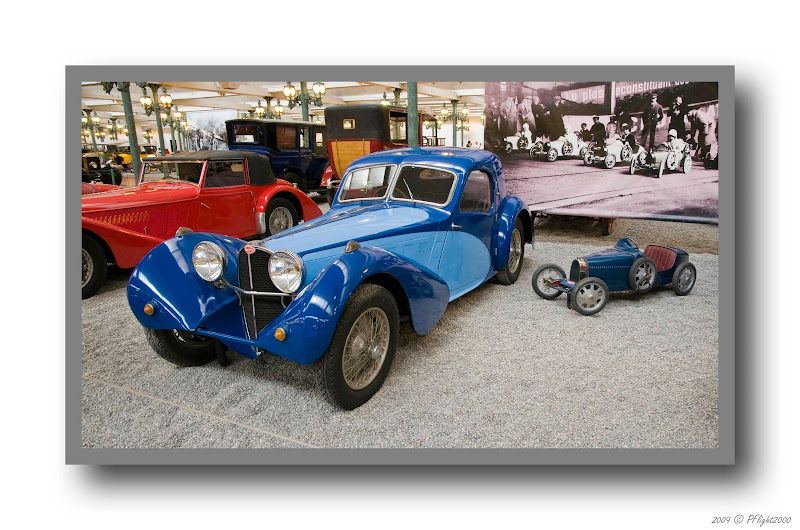 |
| Von Colléction Schlumpf |
The replica of the famous Type 57S Atalante Coupé:
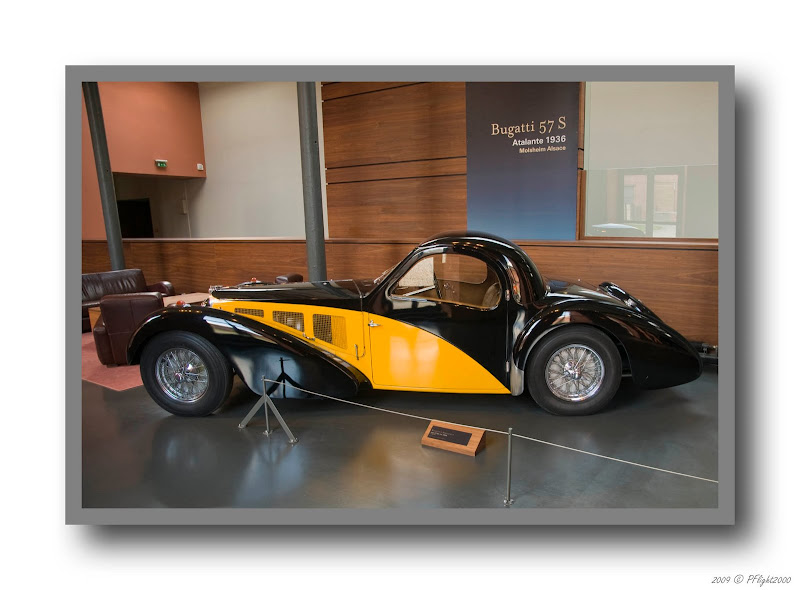 |
| Von Colléction Schlumpf |
Bugatti Type 101
After Ettore's death in 1947 the company only built one more model. But without the genius on the helm, the car remained unsucessful. Actually the company missed to do new developments, and so this car was basically a Type 57 with a new body - so the car was basically 25 years old when actually came out...
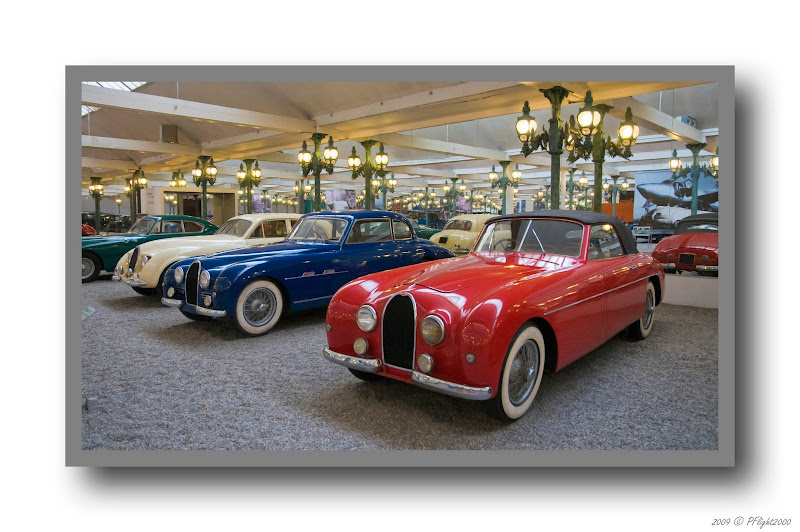 |
| Von Colléction Schlumpf |
This Type 101 obviously does not have its original body anymore. It's been redesigned by an italian designer.
 |
| Von Colléction Schlumpf |
Bugatti Type 251
The attempt to build a car for the new 2.5-liter formula ended in a disaster. Although Gioacchimo Colombo - the father of Ferraris pre-1954 12-cyclinder engines - had designed the engine the car lasted only half a race.
 |
| Von Colléction Schlumpf |
Both Ettore Bugatti and his son Jean had died already years ago, and the small company from Molsheim had financial problems and was taken over by Hispano-Suiza in 1963. In 1966 Simca bought Hispano-Suiza, and the brand Bugatti disappeared.
Bugatti EB 16/4 Veyron
Well, yes, it's a Bugatti... In 1987 Romano Artoli founded the Bugatti International Holding in Luxemburg. He knows people who have money. On September 14 and 15 in 1991 the EB110 is being presented on the Place de la Défence in Paris and in the original factory halls in Molsheim. Many former Ferrari and Lamborghini constructors have worked on the car, but the audience misses the connection with the original Bugattis. 139 cars have been built, plus the prototype of the limousine EB112, when in 1995 the company is going bankrupped. Artoli and his crew have created a financial mess.
When it comes to exotic cars, big brands have the advantage: Ferrari, Alfa Romeo and Maseratti belong to Fiat, Lamborghini once belonged to the Mimram family, before it was sold to Chrysler, then to Mega Tech in Indonesia, and now it belongs to Volkswagen. And Volkswagen also bought the rights of the name Bugatti in 1998. After various design-studies the EB 16/4 Veyron is being presented in 2000, production begins in 2003 in Molsheim - but not in the old factory halls, since they still belong to Hispano-Suiza-Mercier. 16 cylinders, 4 turbochargers, 1001 hp, 406 km/h - that's truly Bugatti-like. Although, not much is left from the myth in this car...
 |
| Von Colléction Schlumpf |
Ferrari 500 TRC
The Testa Rossa saga began in 1957 and ended in 1962. The concept was to create a competitive open-bodied race-car for gentlemen-drivers, who didn't have the opportunity to race for a factory team. So Testa Rossas were hardly ever operated by the Scuderia Ferrari. The model 500 TRC was actually the last ever Ferrari to have a 4-cylinder engine. The Testa Rossa saga found a follow-up in the timeless ugly 512BB Testarossa from 1984.
 |
| Von Colléction Schlumpf |
Although looking roughly the same, this car is not a Testa Rossa. The bodyshops Scaglietti and Fantuzzi in Modena used the same design from Pinin Farina for several open-bodied racing cars, so it's very difficult to tell the difference. This one could be a 412MM or a 860 Monza.
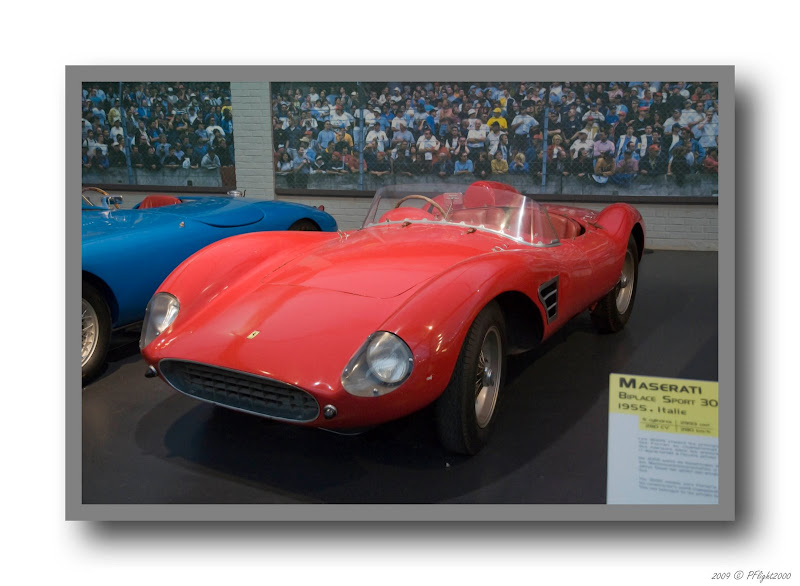 |
| Von Colléction Schlumpf |
Ferrari 250 GT Lusso
The Ferrari 250 in all its variants marked the beginning of the Golden Age for the italian company with the jumping horse. Most of the cars were designed by Pininfarina, who's name by then still was Pinin Farina. Ferrari built a so-called rolling chassis with the engine, and sent this to Scagliatti, who built the body of the car and the interior. This particular car already showed typical 1970s elements back in the late fifties.
 |
| Von Colléction Schlumpf |
Ferrari 250 Le Mans
Although not a real 250 model (the number means the ccm per cylindre) but rather a 330, Ferrari tried to cheat the FIA on this one. The car was presented as a race-variant of the 250 SWB from 1959, but really had nothing in common with this one. The FIA found out what had happened, and the car was banned from the 3-litre races. It had to compete with much more powerful opponents, which eventually lead to the legendary P-Series, ending with the 330 P3 and P4.
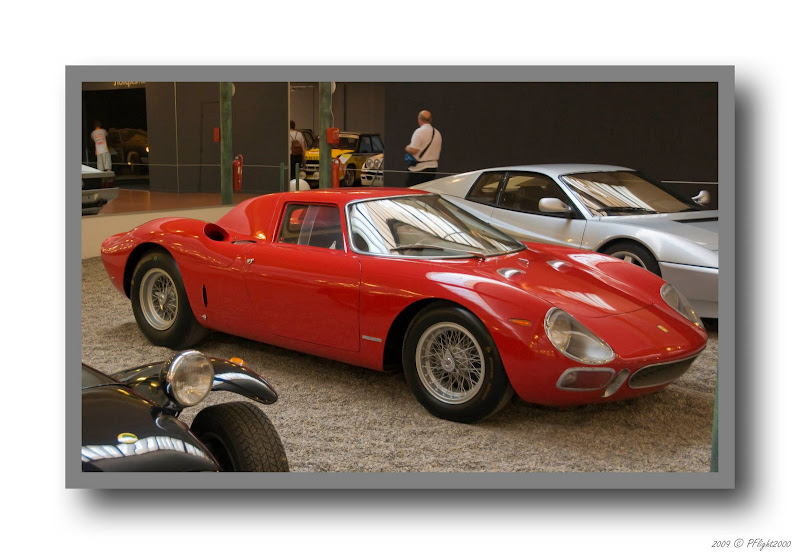 |
| Von Colléction Schlumpf |
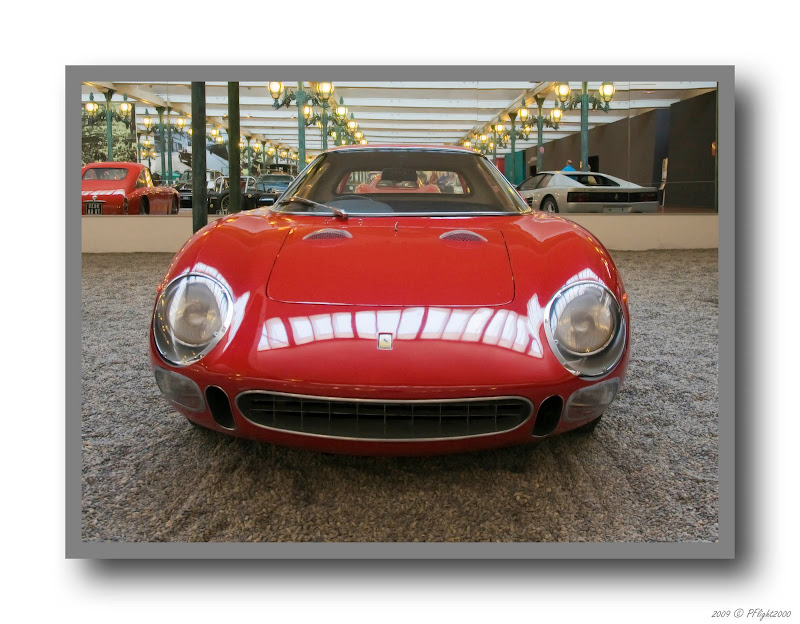 |
| Von Colléction Schlumpf |
Alfa Romeo 8C 2,9 A
With the 8C - stands for 8 cylinders - Alfa Romeo presented a new generation of sports cars in 1931. The car first had 2300 ccm, in 1936 the engine was enlarged to 2900 ccm. About 30 cars were made of that type, with some of the most elegant bodies ever seen and very typical for that time.
 |
| Von Colléction Schlumpf |
Arzens La Baleine
Paul Arzens was a French designer who designed many locomotives for the SNCF. Also he constructed two cars: La Baleine and L'Oef. La Baleine was based on the chassis of a Buick, and wich it's streamline shape it was 40 km/h faster than the american original.
This car is not part of the original Colléction Schlumpf, as it was in use until Azens' death in 1990.
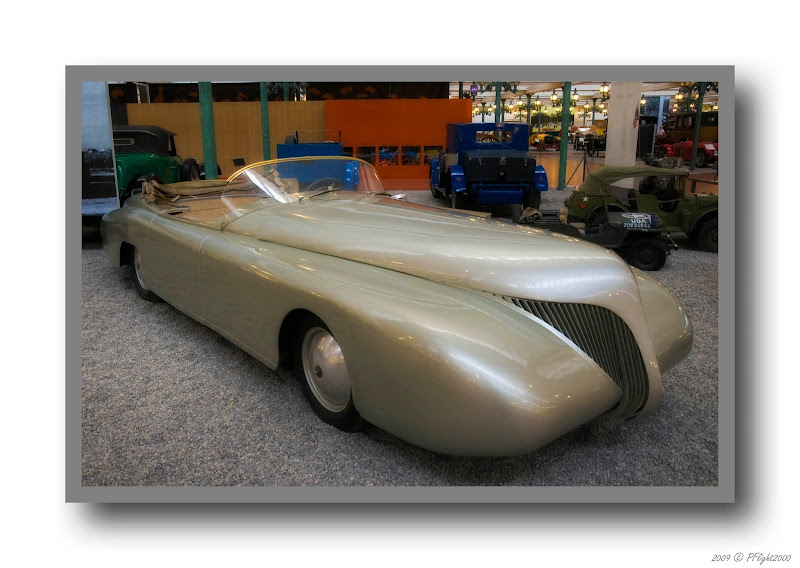 |
| Von Colléction Schlumpf |
 |
| Von Colléction Schlumpf |
Trabant 601
How many people do you need to build a Trabant? 5: Four fold the cardboard, one handles the glue...
This car represents more than anything else the lifestyle in the DDR / GDR. It's twin-stroke engine with 600 ccm produced 27 hp, enough for 107 km/h topspeed.
This car is not part of the original Colléction Schlumpf.
 |
| Von Colléction Schlumpf |
The Group B Monsters
Ford RS200
Peugeot 205 Turbo 16
In 1984 the FIA introduced a new formula into Rally Sports: Group B. I won't bother you with reglementation details, just so much: Allowed was basically everything, as long as you produced 200+ cars of that model. This lead to this legendary Peugeot 205 Turbo 16, with 500 hp, AWD, and a weight of only 900 kg. The engine was mounted in the middle of the car, behind the driver's and copilot's seat. Technically these cars had absolutely nothing in common with the 'original' 205 that populated european streets in the 80s and 90s, the RS200 never even had a 'brother' for normal street use. Once unleashed, the engine turned the care into a rocket on wheels, hardly controllable by its driver. Many fatal accidents within a very short period forced the FIA to bring this adventure to an end in 1986. Never again have so highly overpowered vehicles entered a rally-track, but the thundering sound of the engines, the puffing of the whastegate-valves and the turbine-like whining of the gearbox still brings goosebumps to fans.
These cars are not part of the original Colléction Schlumpf.
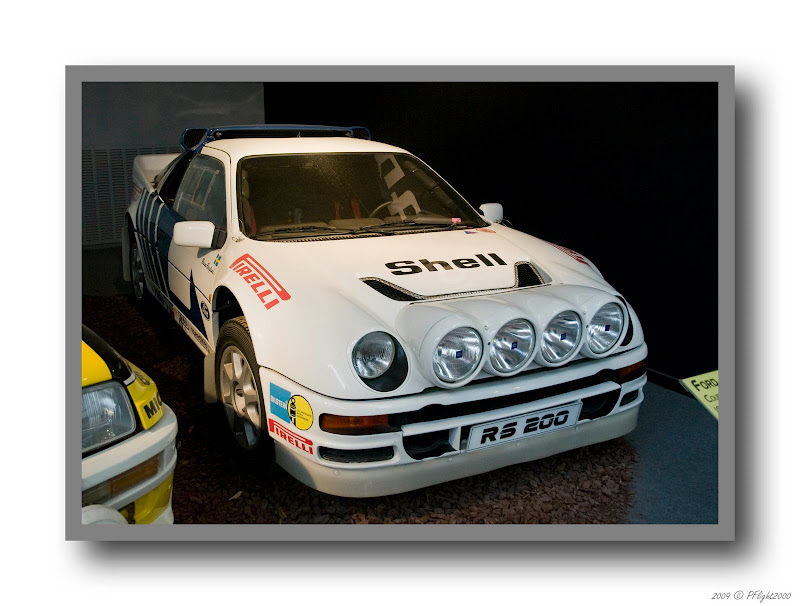 |
| Von Colléction Schlumpf |
 |
| Von Colléction Schlumpf |
Here's for some Action:
Mercedes-Benz 300 SL Roadster
After the success of the SSL and the W154 forumla cars back in the 30s Mercedes-Benz tried to catch up to the Ferraris and Porsches after WWII. The result was the 300 SL, which was built as coupes and roadsters, both for normal use and for racing.
 |
| Von Colléction Schlumpf |
Porsche 962
In the early 80s Porsche dominated the so-called Group C with the model 956 and its successor 962. The engine was an evolution-version of the original 911 engine.
This car is not part of the original Colléction Schlumpf.
 |
| Von Colléction Schlumpf |
Audi R8
The successor of the Group C in track racing is todays Le Mans Series. The peak of the series is the 24 heurs du Mans, the 24 hour race. The prototypes are the kings of the road, and Audi won the race 6 times with the R8, plus many more races in total.
This car is not part of the original Colléction Schlumpf.
 |
| Von Colléction Schlumpf |
PS: I appologize for the messup with the name Franco Sbarro in the first version of this blog, and I want to point it out very clearly here: Franco Sbarro had NOTHING to do with the Bugatti-disaster in the early nineties. He was not involved in the EB110 project. His connection with the name Bugatti is a replica of the Type 41 Royale that has been built until 1983.
Freitag, 7. August 2009
PFlight in Alsace
Let's face the facts: A mobile home is a convenient way to spend your holiday on a camping ground. You fill the car with all the stuff you think you might need, like clothes, food, drinks, toiletry, laptop, camera, bicycle, etc, etc, and then you drive to the camping of your choice. If you're lucky enough they have still some place for your vehicle, so you park it, plug in the electricity, turn on the gas for the kitchen, and there you go. Happy camping!
So far, so good. Now, in my case the car was 5.5 meters long, 2 meters wide and 2.3 meters high. The camping ground wasn't the problem. BUT: Imagine you have to drive that thing somewhere because you want to see some of the beautiful cities in the area! I drove over to the beautiful region of Alsace in France, so the plan was to visit Strasbourg for the European Parliament and of course the huge cathedral, and to visit also Colmar for the famous altar of Isenheim, painted by Matthias Grunewald. Believe it or not: I didn't find any parking place in either city where you can park a car higher than 2 meters for longer than 2 hours!!! And if you park there, you really get ripped off! In Colmar these parkings cost twice the price for a normal car parking...
In Strasbourg I parked the car for two hours, rushed for the cathedral for a couple of pictures, rushed back to the car and left the city in frustration. In Colmar I didn't even park, I was so frustrated after searching for a parking for more than an hour, so I left the city without having even really stopped.
I ended up in Mulhouse that day, at the National Car Museum with the huge 'Collection Schlumpf'. I'll tell you more about that later.
At least I spent two wonderful evenings in the beautiful village of Ribeauville. But the short trip left a bit of a bad taste after what I've experienced. One tends to think 'what do you expect from a land where they eat snails and frogs', but that's unfair since my parents experienced the same in Germany and Spain with the very car.
Here are some pics:
A stork walking around in the camping Pierre de Coubertin in Ribeauville
Dramatic lighting by a nearing thunderstorm in Ribeauvile
Ruined castle in the distance
After the thunderstorm
The next evening showed 25°C and sunshine
The famous Metzger tower in Ribeauville
Beautifully lit house: The light comes from the fassade of the next house, which is also painted yellow
Full moon rising - some of you might know a similar scene, seen about a year ago in West Van
The giant Munster of Strasbourg - unbelieveable how they managed to build this a couple of hundred years ago!
The entrance with the huge round window above it
Beautiful old house next to the cathedral. It's a restaurant now.
That's it, hope you liked the pics! Pictures of the Collection Schlumpf and the story to that museum follows later.
So far, so good. Now, in my case the car was 5.5 meters long, 2 meters wide and 2.3 meters high. The camping ground wasn't the problem. BUT: Imagine you have to drive that thing somewhere because you want to see some of the beautiful cities in the area! I drove over to the beautiful region of Alsace in France, so the plan was to visit Strasbourg for the European Parliament and of course the huge cathedral, and to visit also Colmar for the famous altar of Isenheim, painted by Matthias Grunewald. Believe it or not: I didn't find any parking place in either city where you can park a car higher than 2 meters for longer than 2 hours!!! And if you park there, you really get ripped off! In Colmar these parkings cost twice the price for a normal car parking...
In Strasbourg I parked the car for two hours, rushed for the cathedral for a couple of pictures, rushed back to the car and left the city in frustration. In Colmar I didn't even park, I was so frustrated after searching for a parking for more than an hour, so I left the city without having even really stopped.
I ended up in Mulhouse that day, at the National Car Museum with the huge 'Collection Schlumpf'. I'll tell you more about that later.
At least I spent two wonderful evenings in the beautiful village of Ribeauville. But the short trip left a bit of a bad taste after what I've experienced. One tends to think 'what do you expect from a land where they eat snails and frogs', but that's unfair since my parents experienced the same in Germany and Spain with the very car.
Here are some pics:
A stork walking around in the camping Pierre de Coubertin in Ribeauville
 |
| Von Elsass |
Dramatic lighting by a nearing thunderstorm in Ribeauvile
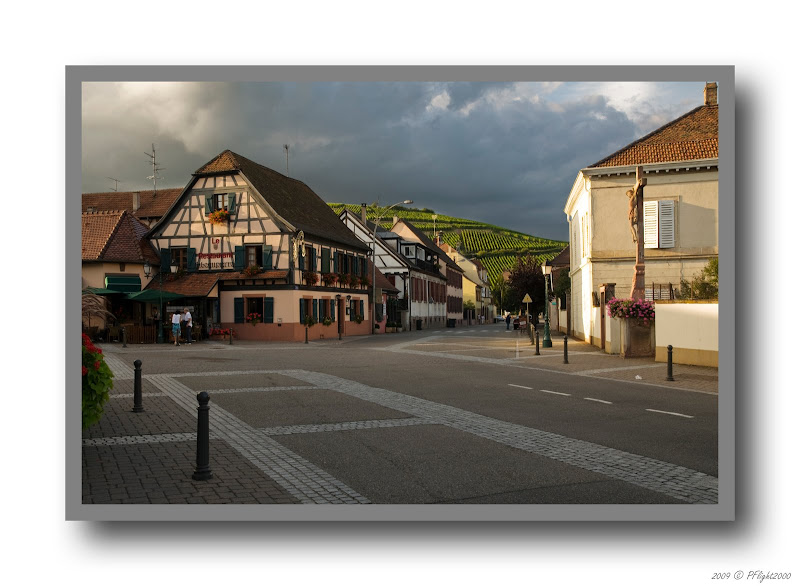 |
| Von Elsass |
Ruined castle in the distance
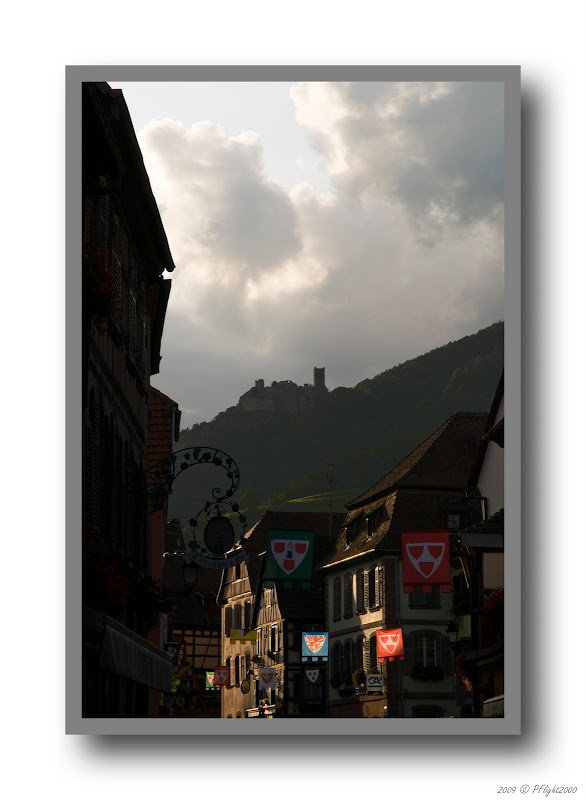 |
| Von Elsass |
After the thunderstorm
 |
| Von Elsass |
The next evening showed 25°C and sunshine
 |
| Von Elsass |
The famous Metzger tower in Ribeauville
 |
| Von Elsass |
Beautifully lit house: The light comes from the fassade of the next house, which is also painted yellow
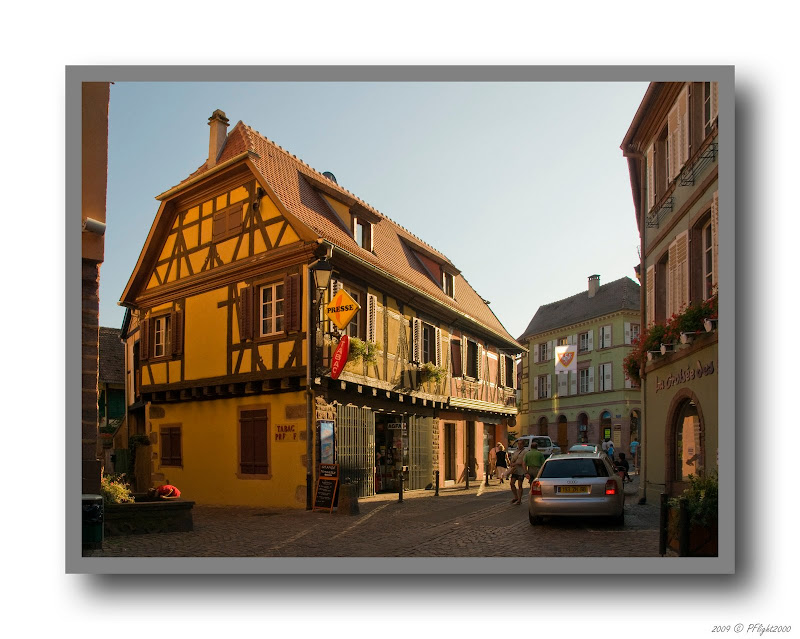 |
| Von Elsass |
Full moon rising - some of you might know a similar scene, seen about a year ago in West Van
 |
| Von Elsass |
The giant Munster of Strasbourg - unbelieveable how they managed to build this a couple of hundred years ago!
 |
| Von Elsass |
The entrance with the huge round window above it
 |
| Von Elsass |
Beautiful old house next to the cathedral. It's a restaurant now.
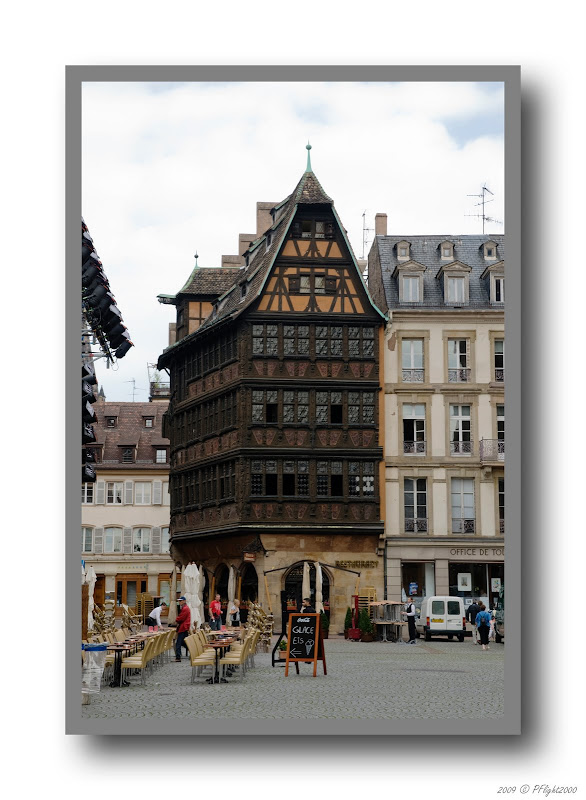 |
| Von Elsass |
Abonnieren
Posts (Atom)